Get Maximum Fortnite Performance: 'Epic' Mode With 10 Graphics Cards
Our Conclusions (and Bonus Testing With GeForce GTX 1080 vs. Radeon RX Vega 64)
The GeForce GTX 1060 6GB and Radeon RX 580 struggled to run at 1920x1080 under the Epic quality preset. But our host processor appears to have plenty of headroom left. So let's take a look at what a couple of high-end graphics cards can do to push our platform harder.
In this round of tests, we drop a GeForce GTX 1080 Founders Edition and a Radeon RX Vega 64 into the Ryzen-based PC, maintaining a 1920x1080 resolution and the Epic preset with Show Grass enabled.



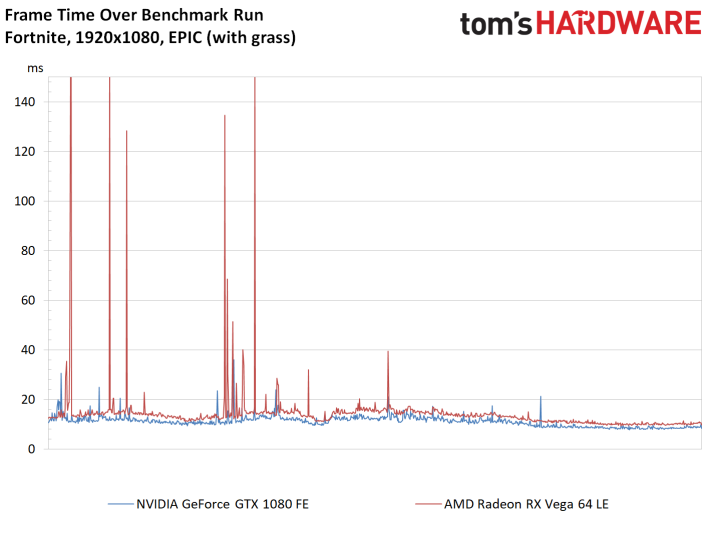
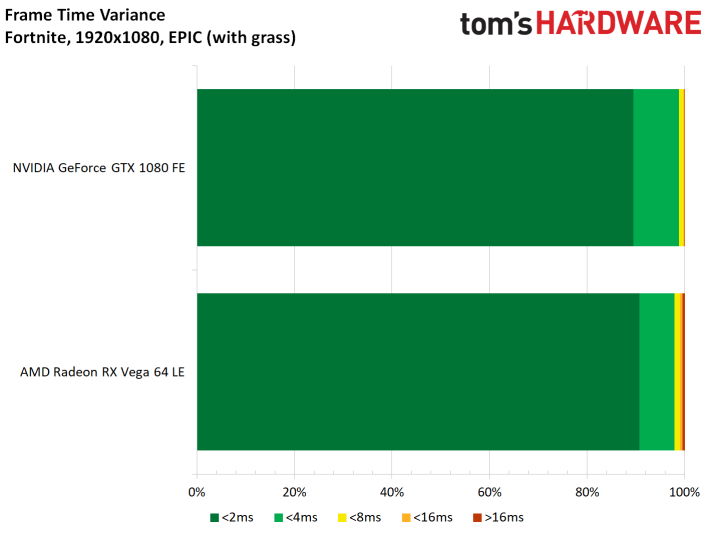

While AMD's Radeon RX Vega 64 falls below our 60 FPS floor once, the GeForce remained above that threshold through our test sequence. Unsurprisingly, both cards offer smooth game play, even if the Radeon demonstrates some significant frame-time spikes.
Processor Utilization
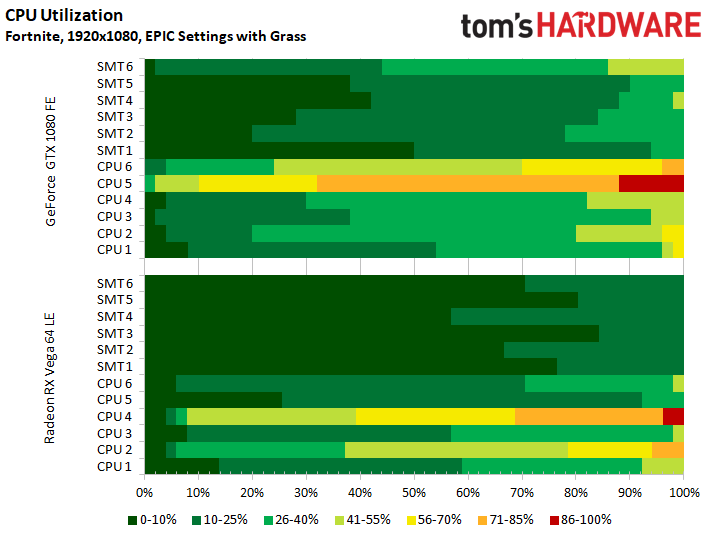


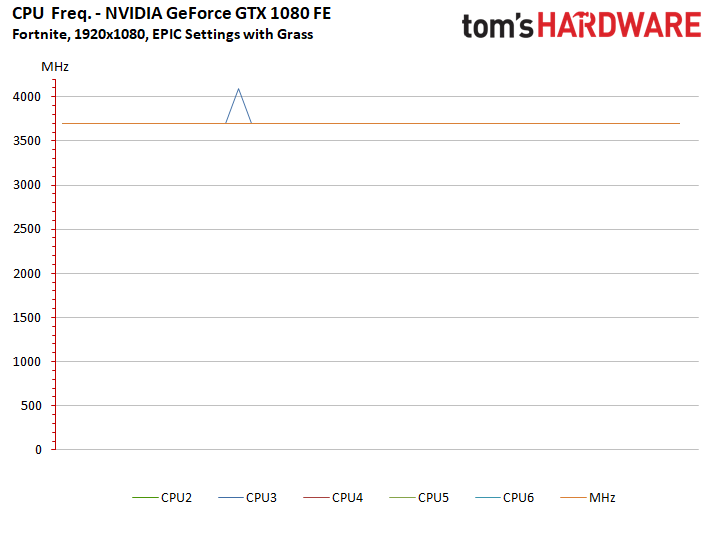

When it comes to CPU utilization, Unreal Engine 4 still operates mostly across two cores, leaving the others far less occupied. Overall usage is definitely higher with these two high-end graphics cards installed, though, which is definitely understandable, since higher frame rates force the CPU to do more work.
Processor Utilization at 144 FPS and 240 FPS
Now, let's focus on specific frame rates. We want to know if host processing comes into play as a limiting factor when you try to run at 144 or 240 FPS. Of course, hitting those performance levels means dialing down the graphics quality, even on our high-end cards. Medium and High quality settings with Shadows disabled are what we need to get there.
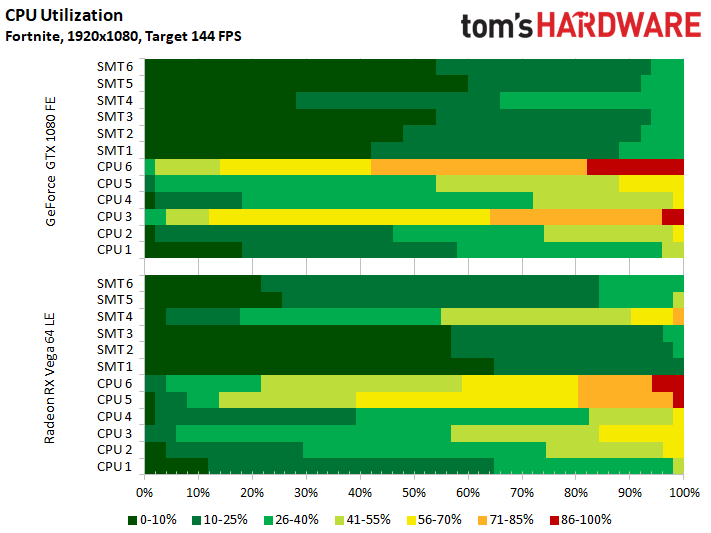
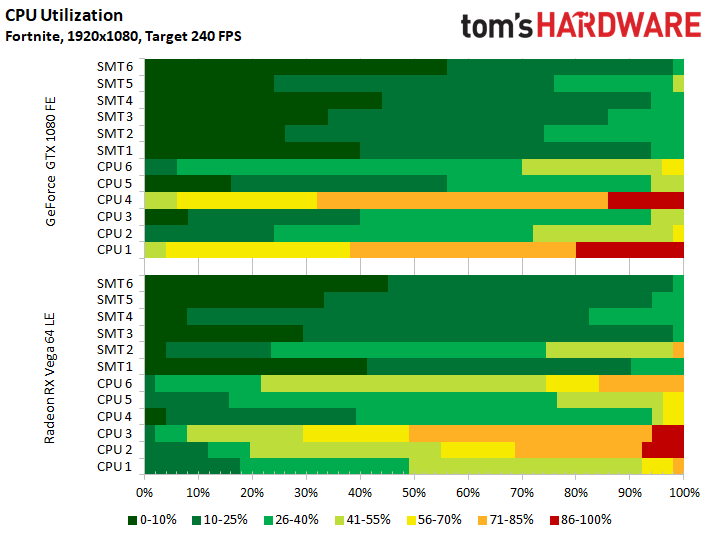
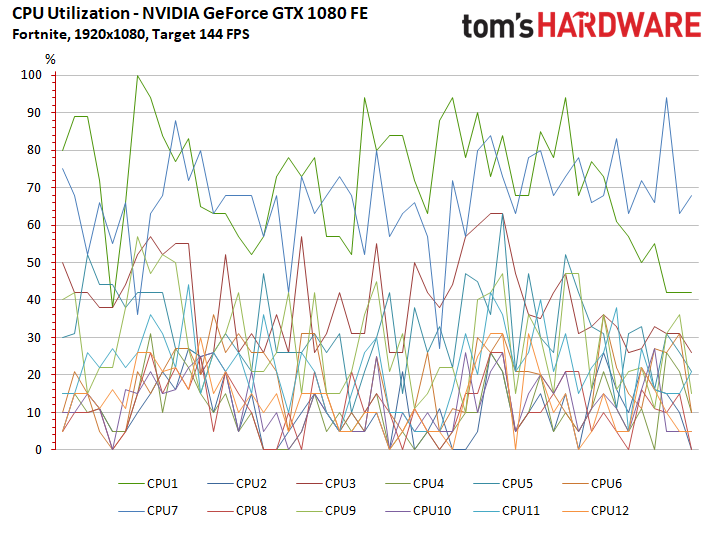


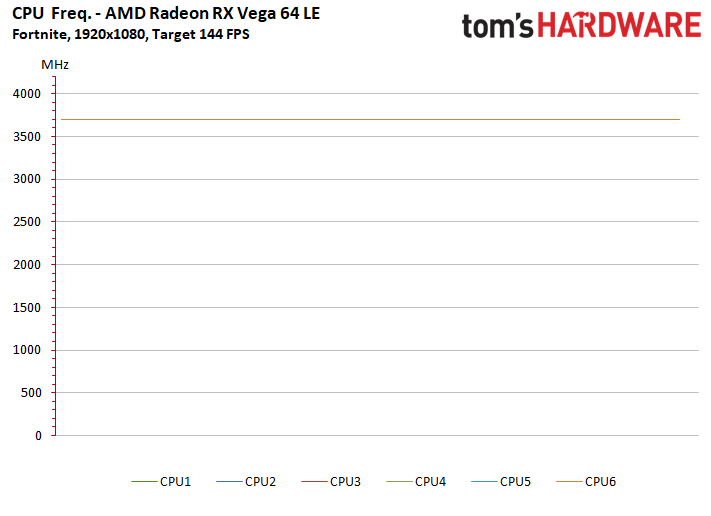

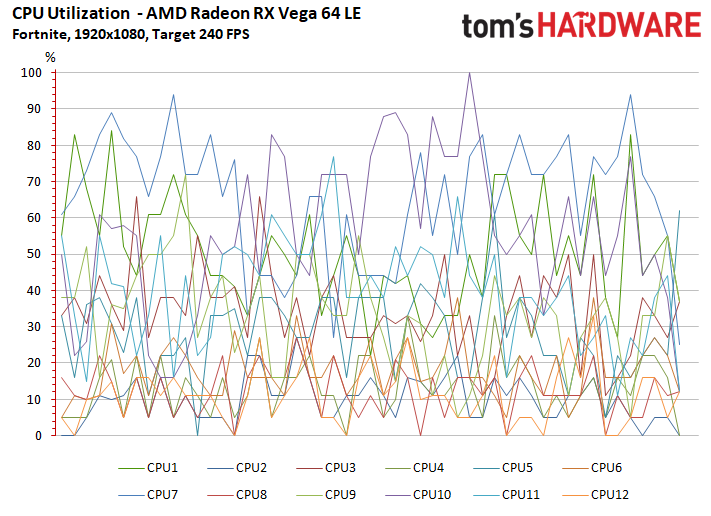


Although we still see two cores most heavily utilized (sometimes fully), the game engine takes advantage of other cores this time, too. Tim Sweeney's words prove accurate: Unreal Engine 4 does seem capable of exploiting the Ryzen CPU's resources, just not in a perfectly homogeneous fashion.
Our Conclusions
Based on the Unreal Engine 4 game engine, Fortnite is playable on a wide range of system configurations, from entry-level to high-end, thanks to a panoply of graphics settings. How you toggle those settings on and off has a large (and variable) impact on performance. For example, the Shadows option has the biggest effect on frame rates, in our experience, particularly on lower-end GPUs.
Get Tom's Hardware's best news and in-depth reviews, straight to your inbox.
We definitely recommend a card based on the GeForce GTX 1060 3GB/6GB or the Radeon RX 580 to push the detail settings as high as possible at 1920x1080. With a less powerful graphics card, you'll have to sacrifice either quality or resolution.
Don't worry as much about your CPU. While Unreal Engine 4 is certainly capable of making use of multiple cores, it does so in an unbalanced fashion (in Fortnite, at least). Our findings show that two cores are really all you need. At least this makes it possible for the game to run smoothly at Full HD on a fairly low-end platform, so long as you have enough graphics horsepower to burn and a high enough clock rate.
MORE: Final Fantasy XV Performance Review
MORE: Project CARS 2 Performance Review
MORE: Star Wars Battlefront II Performance Review
Current page: Our Conclusions (and Bonus Testing With GeForce GTX 1080 vs. Radeon RX Vega 64)
Prev Page How Fortnite Uses Multiple Cores-
Gillerer I have a couple of suggestion to improve the readability of the CPU load chart - and make it more informative:Reply
*
1) Analyze the CPU thread loads in descending order:
■Record loads per CPU thread for each point in time.
■For each data point, assign the loads to graphs called "Highest loaded thread", "2nd highest", "3rd highest", ..., "Nth highest". (The spreadsheet function LARGE is your friend here.)
■Display these as you do now - only now the top bar displays how the highest loaded CPU thread - whatever thread it happened to be at the time - was doing throughout the entire test.
I think this display would be better than the current one, because you could see the performance profile at a glance: the colors would shift from highly loaded at the top to slightly loaded at the bottom. E.g. you could easily see how much of the time 4 or more threads were highly loaded *at the same time*. The current graph doesn't show this definitely, since the high loads on the two threads may have occurred at different times in the test.
*
2) Change the value groups of the CPU load: 86% to 100% is much too wide of a gap. I'd like there to be a "fully loaded" group of 99 - 100% (maybe 98 - 100%, or 98.5 - 100%, depending on the precision of the data recording). I feel this is very important, since it would indicate an almost certain CPU bottleneck. -
Ninjawithagun WOW! I'm impressed by the fact that the GTX970 can still hang in there with playable frame rates at 1440P :DReply -
Jamie_69 well, that's unequivocally false, but don't let that stop you posting nonsense - I'm sure it won'tReply
edit for context- the post i was replying to was a now deleted angry rant -
alextheblue ReplyUnreal Engine 4 does seem capable of exploiting the Ryzen CPU's resources, just not in a perfectly homogeneous fashion.
Maybe some other UE4 game. Unless by "not in a perfectly homogeneous fashion" you actually meant "unevenly taxes CPU cores and manages to use perhaps 50% of available horsepower under the very best of circumstances, using a mid-tier chip paired with a top-end GPU at settings geared for extremely high framerates".
Fortnite is deliberately built to NOT be CPU intensive so that it can run on a wide range of systems. You turn down the eye candy until your graphics can handle it, and your CPU is not a big concern. -
mario.abarth89 Damn, from the title i hoped you took a mining mainboard and somehow made it work with all 10 at the same time :(Reply -
jpe1701 Reply20862675 said:I have a couple of suggestion to improve the readability of the CPU load chart - and make it more informative:
*
1) Analyze the CPU thread loads in descending order:
■Record loads per CPU thread for each point in time.
■For each data point, assign the loads to graphs called "Highest loaded thread", "2nd highest", "3rd highest", ..., "Nth highest". (The spreadsheet function LARGE is your friend here.)
■Display these as you do now - only now the top bar displays how the highest loaded CPU thread - whatever thread it happened to be at the time - was doing throughout the entire test.
I think this display would be better than the current one, because you could see the performance profile at a glance: the colors would shift from highly loaded at the top to slightly loaded at the bottom. E.g. you could easily see how much of the time 4 or more threads were highly loaded *at the same time*. The current graph doesn't show this definitely, since the high loads on the two threads may have occurred at different times in the test.
*
2) Change the value groups of the CPU load: 86% to 100% is much too wide of a gap. I'd like there to be a "fully loaded" group of 99 - 100% (maybe 98 - 100%, or 98.5 - 100%, depending on the precision of the data recording). I feel this is very important, since it would indicate an almost certain CPU bottleneck.
I second a change with the load charts. Maybe I am just slow but I have a hard time reading them.
-
buzznut47 The graphics are pretty weak considering how much hardware processing power is required. Cartoonish really. I doubt that has much to do with Unreal Engine 4.Reply
Also the recommended specs from the game devs seem really underpowered. Would have liked to see just how low the settings would have to be under those conditions. -
interspool How were you able to set core affinities in the first place? It looks as though they've patched the game and it won't allow users to set affinity in Windows 10 or Process Lasso for the Fortnite exe. I want to lock the game to 4 cores, and use my other 4 cores for streaming. Someone please help!Reply


